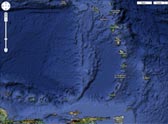Home >> Trinidad >> Read about >> Magician of the carnival: Peter Minshall turns thousands of people into work of art
Trinidad

Magician of the carnival: Peter Minshall turns thousands of people into work of art
Just wearing a red nose is not enough. If you want to be part of carnival in Trinidad, you have to join one of the masquerade groups. Two dozens of such masbands compete with each other for the best costume designs. One of them has made dressing up at carnival a form of art. Each year Peter Minshall and his Callaloo Company turn thousands of people into a living work of art.
By Bernhard Grdseloff
By Bernhard Grdseloff
"I don’t make costumes, I create ways to express human energy", is how the magician of carnival outlines his work. The graduate of the London College of Art and Design detests Las Vegas style skimpy feather glitter. When his masked parade passes by, luxuriantly flowing fabrics and colorful flags fill the streets of Port of Spain. Often there’ll be forty different masks on one topic, and huge dancing figures moving in between them.
This kind of magnificence has its price. Every carnival season, the Callaloo Company uses around 20 miles of fabric in more than 30 colors to create 2,500 to 3,000 costumes. That’s how many people take part in Minshall’s Masband each year, making up his "tribe", as the 61 year-old puts it.
Each year the chieftain presents a topic to his tribe, mostly relating to some current issue. In 2003 it was the "Ship of fools" – the world as a space ship full of maniacs. The Callaloo Company creates costume samples according to the designs of Peter Minshall, which are displayed in a mas camp and presented in the Internet. The fans only buy the masks if they like them. "Our kind of carnival represents theatre in its most original form", says Minshall. "In Europe people pay to watch, here they pay to join in".
The way the actors play their role is up to them. "We do give each person buying a costume an leaflet explaining the philosophy behind the topic", says the transformation artist. "But its up to them what to do when it comes to actually dancing in the streets."
The fine art of carnival
The carnival costumes by Peter Minshall are works of art. This is particularly true of the over-sized masks of the "Kings" and "Queens" (photo). Each year the artist creates at the most three or four of these magnificent specimens as central figures of the respective costume topic. The enormous structures made of fabric, wire and glass fibre are mounted on rollers, amplifying each movement of the person carrying them. Those wanting to shine at carnival with a work of art of this kind will need to lay out 5,000 US-US-Dollars at least. Standard costumes, by contrast, are priced at 150 to 250 Dollars
This kind of magnificence has its price. Every carnival season, the Callaloo Company uses around 20 miles of fabric in more than 30 colors to create 2,500 to 3,000 costumes. That’s how many people take part in Minshall’s Masband each year, making up his "tribe", as the 61 year-old puts it.
Each year the chieftain presents a topic to his tribe, mostly relating to some current issue. In 2003 it was the "Ship of fools" – the world as a space ship full of maniacs. The Callaloo Company creates costume samples according to the designs of Peter Minshall, which are displayed in a mas camp and presented in the Internet. The fans only buy the masks if they like them. "Our kind of carnival represents theatre in its most original form", says Minshall. "In Europe people pay to watch, here they pay to join in".
The way the actors play their role is up to them. "We do give each person buying a costume an leaflet explaining the philosophy behind the topic", says the transformation artist. "But its up to them what to do when it comes to actually dancing in the streets."
The fine art of carnival
The carnival costumes by Peter Minshall are works of art. This is particularly true of the over-sized masks of the "Kings" and "Queens" (photo). Each year the artist creates at the most three or four of these magnificent specimens as central figures of the respective costume topic. The enormous structures made of fabric, wire and glass fibre are mounted on rollers, amplifying each movement of the person carrying them. Those wanting to shine at carnival with a work of art of this kind will need to lay out 5,000 US-US-Dollars at least. Standard costumes, by contrast, are priced at 150 to 250 Dollars













